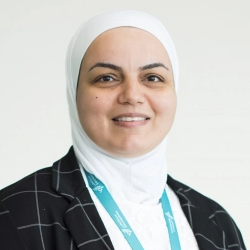Invited Speakers


Dr. Ian S. Haworth
Associate Professor and Vice Chair of Pharmacology and Pharmaceutical Sciences
University of Southern California, California, USA
Principles of in-silico Approaches in Pharmacology Research
Abstract
In silico methods are increasingly important in drug discovery and development. These methods include molecular-based computational approaches using molecular modeling and docking; simulation of pharmacokinetics using compartmental and physiologically based pharmacokinetic (PBPK) modeling, and use of machine learning to build complex models of molecular events and use these models for prediction. In this talk, examples of these three areas will be discussed based on recent work in our laboratory. First, modeling approaches using explicit solvation can improve understanding of the role of water at molecular interfaces. We have developed Solvate/Watgen as an algorithm for prediction of interface solvation, as a basis for ligand design incorporating solvent retention and exclusion. Second, compartmental and PBPK methods will be described for prediction of environmental toxicological effects and for detailed understanding of molecular events modulating drug disposition, using GastroPlus software. Finally, a machine learning approach using molecular descriptors will be discussed for prediction of inhibitors of tau fibril formation, using the KNIME software platform.
Biography
Dr. Ian Haworth is an Associate Professor and Vice Chair of the Department of Pharmacology & Pharmaceutical Sciences in the Mann School of Pharmacy & Pharmaceutical Sciences at the University of Southern California. He received his Ph.D. in Physical Organic Chemistry from the University of Liverpool, UK, and then spent three years as a Postdoctoral Fellow at the University of Oxford, UK before joining USC. His research work lies at the interfaces of chemistry, biochemistry, and computation. This work involves development and utilization of algorithms for prediction of drug-protein molecular interactions and simulation of ADME properties of drugs. Dr. Haworth's laboratory has published more than 100 scientific articles on this work. Current projects include examining the relationship of affinity with solvation at drug-protein interfaces; physiologically based pharmacokinetic (PBPK) modeling aimed at mechanistic understanding of drug disposition; and use of cheminformatics and machine learning in prediction of molecular association. Dr. Haworth also has a major role in teaching of medicinal chemistry and biopharmaceutics at USC, and he has lectured and taught courses on this content worldwide. He is also currently co-Director of the International Summer Program in the USC Mann School of Pharmacy. Dr. Haworth has utilized problem-based learning in teaching of science courses for many years, and he has published and presented widely on these educational approaches. He is also interested in utilization of computational methods in evaluation of educational outcomes, including new approaches to curriculum mapping and assessment.

Dr. Mona Minkara
Assistant Professor of Bioengineering
Northeastern University, Massachusetts, USA
Deciphering the Enhanced Antiviral Activity of Double Mutant Surfactant Protein-D Binding with Trimannose on Influenza A: Insights from Molecular Dynamics Studies
Abstract
Deciphering the Enhanced Antiviral Activity of Double Mutant Surfactant Protein D Binding with Trimannose on the Influenza A Virus: Insights from Molecular Dynamics Studies Surfactant protein D (SP-D) is a member of the collectins, collagen-containing lectin proteins that belong to a broader category of pattern recognition receptors, fundamental to the primary immune defense. SP-D serves as a barrier against pathogens, including bacteria, fungi, and viruses. While wild-type SP-D binds these pathogens, previous studies have shown its antiviral activity against Influenza A Virus is limited; however, a double mutant SP-D, with mutations Asp325Ala and Arg343Val, shows enhanced inhibitory effects. The molecular basis for this enhanced binding to viral glycans is not fully understood. In our research, we employ microsecond-scale molecular dynamics simulations, paired with free energy perturbation and quantum mechanics. Using trimannose as a model and considering over twelve different glycan binding poses and point mutation models, we seek to understand the mutant SP-D's heightened antiviral properties. Our findings pave the way for designing optimized SP-D variants for improved pathogen specificity
Biography
Dr. Mona Minkara is an Assistant Professor in the Department of Bioengineering and an Affiliate Faculty in the Department of Chemistry and Chemical Biology at Northeastern University. She received her Bachelor of Arts from Wellesley College and her Ph.D. in Chemistry from the University of Florida. Dr. Minkara is the head of the COMBINE (Computational Modeling for Biointerface Engineering) Lab, which focuses on the study of pulmonary surfactant, a complex protein-lipid substance secreted by the alveoli in the lungs and its potential therapeutic applications in the medical field. Dr. Minkara specializes in using an array of computational tools to apply to biomolecular problems, and her laboratory is developing innovative approaches that combine protein and surfactant modeling to investigate the PS system computationally. As a blind scientist, she is committed to making science more accessible and inclusive through engineering new tools for blind and partially sighted scientists, and she is involved in several projects dedicated to promoting accessibility in STEM fields. The importance of interdisciplinary research is emphasized in her work, which highlights the efficacy of computational methods in drug discovery and elucidating the complexities of the pulmonary surfactant (PS) system.

Dr. Souhaila Al Khodor
A/ Executive Director- Translational Medicine Department
Director-Maternal and Child Health Division
Sidra Medicine
Multi-omics and AI in the era of precision medicine
Abstract
Recent advances in the field of omics , bioinformatics and artificial intelligence have empowered us with novel ways to understand disease pathogenesis and improve patient outcomes. Systems level characterization of biological data including genomics, epigenomics, metabolomics, metagenomics and proteomics is becoming not only feasible, but also essential for unraveling the complex interactions in health and disease.
Using machine learning tools and algorithms, it is possible to integrate multiomics data with clinical information to develop predictive models that identify risk before the disease is clinically apparent, thus facilitating early interventions to improve patients’ health.
During my presentation, I will cover some of the recent research performed in my laboratory at Sidra Medicine, where the integration of multi-omics and AI has been instrumental in identifying biomarkers of various diseases affecting maternal and child health. These advancements are propelling us closer to the forefront of precision medicine and the transformation of healthcare.
Biography
Dr. Al Khodor is the Acting Executive Director of Translational Medicine Department and the Director of Maternal and Child Health Division in the Research Branch at Sidra Medicine, Qatar.
Dr. Al Khodor received her Bachelor’s degree in Medical Lab. technology from the Faculty of Public Health at the Lebanese University in 2001. Soon after, she started her master’s degree in microbiology and Immunology at the American University of Beirut (2002-2004). Dr. Al Khodor received her second master’s degree and PhD in Microbiology and Immunology from the University of Louisville, Louisville, KY, USA (2005-2008). Before joining Sidra, Dr. Al Khodor worked as a postdoctoral fellow in the Signaling systems Unit, laboratory of Systems Biology, at the National Institute of Allergy and infectious Diseases (NIAID), National Institutes of Health (NIH) in Maryland, USA.
Dr. Al Khodor’s laboratory in Sidra focuses on characterizing the role of the microbiome in health and disease, with a particular emphasis on maternal and child health and the integration of metagenomics with other omics aiming to identify predictive markers for various diseases and pathological conditions.
Dr. Al Khodor is an adjunct Faculty at the College of Health & Life Science in Hamad Bin Khalifa University, and an Adjunct Assistant Professor at the Department of Biomedical Sciences, College of Health Sciences in Qatar University.
Dr. Al Khodor has over 67 peer-reviewed publications. She currently serves as an Assistant Specialty Chief Editor for Frontiers in Cellular and Infection Microbiology and is the Section Editor for Metagenomics in the Journal of Translational Medicine.

Dr. Mohammad Asif Khan
Associate Dean, Computing and IT
University of Doha for Science and Technology, Qatar
President, Asia Pacific Bioinformatics Network (APBioNET)
Human ACE2 orthologous peptide sequences show better binding affinity to SARS-CoV-2 RBD domain: Implications for drug design
Abstract
Computational methods coupled with experimental validation play a critical role in the identification of novel inhibitory peptides that interact with viral antigenic determinants. The interaction between the receptor binding domain (RBD) of SARS-CoV-2 spike protein and the helical peptide of human angiotensin-converting enzyme-2 (ACE2) is a necessity for the initiation of viral infection. Herein, natural orthologs of human ACE2 helical peptide were evaluated for competitive inhibitory binding to the viral RBD by use of a computational approach, which was experimentally validated. A total of 624 natural ACE2 orthologous 32-amino acid long peptides were identified through a similarity search. Molecular docking was used to virtually screen and rank the peptides based on binding affinity metrics, benchmarked against human ACE2 peptide docked to the RBD. Molecular dynamics (MD) simulations were done for the human reference and the Nipponia nippon peptide as it exhibited the highest binding affinity (Gibbs free energy; −14 kcal/mol) predicted from the docking results. The MD simulation confirmed the stability of the assessed peptide in the complex (−12.3 kcal/mol). The top three docked-peptides (from Chitinophaga sancti, Nipponia nippon, and Mus musculus) and the human reference were experimentally validated by use of surface plasmon resonancetechnology. The human reference exhibited the weakest binding affinity (Kd of 318–441 pM) among the peptides tested, in agreement with the docking prediction, while the peptide from Nipponia nippon was the best, with 267–538-fold higher affinity than the reference. The validated peptides merit further investigation. This work showcases that the approach herein can aid in the identification of inhibitory biosimilar peptides for other viruses.
Biography
Dr. Mohammad Asif KHAN joined the University of Doha for Science and Technology (UDST) in early 2023 as a Professor and Associate Dean at the College of Computing and Information Technology. He holds a PhD from the prestigious National University of Singapore, where he also earned his MSc and B.Appl.Sc degrees. Following the completion of his doctoral studies, Dr. Khan was recruited as a faculty member at the renowned Johns Hopkins University (JHU) in the United States. Shortly thereafter, he was selected to be part of a pioneering team from JHU tasked with establishing a presence in Malaysia as part of a collaboration with the newly established Perdana University (PU), which operated under the auspices of the Malaysia Prime Minister's office. At PU, Dr. Khan played a pivotal role in its foundation, serving as the Founding Director of the Centre for Bioinformatics and later as the Founding Dean of the School of Data Sciences. Recognizing the importance of fostering academic entrepreneurship, he also established a startup division within the school and served as its inaugural CEO. In addition to his contributions to PU, Dr. Khan's expertise led to his appointment as a Professor at Bezmialem Vakif University in Istanbul, Turkey, where he was seconded through the prestigious "International Fellowship for Outstanding Researchers" awarded by the Scientific and Technological Research Council of Turkey. Dr. Khan's extensive academic and entrepreneurial journey demonstrates his commitment to advancing education and research in the fields of computing, information technology, and data sciences on a global scale.

Dr. Christopher W. Cunningham
Chair of Chemistry Section
American Association of Colleges of Pharmacy (AACP)
Associate Professor of Pharmaceutical Sciences
School of Pharmacy, Concordia University, Wisconsin, USA
Translation of pharmaceutical science and drug discovery into practice: 10 years of a molecular modeling project in a pharmacy curriculum
Abstract
As pharmacists are the medications experts on the healthcare team, they are frequently called upon to communicate the basic science underpinnings of drug action to broad audiences. The traditional lecture format often used in higher education is often inadequate to prepare students for this task. Increasingly, pharmacy educators are called upon to use more tactile methods that allow students to explore complex concepts more deeply and practice communicating basic science to fellow practitioners and patients. Since opening in 2010, the Concordia University Wisconsin School of Pharmacy have incorporated a molecular modeling project into a Pharmacology and Medicinal Chemistry course sequence. What began as a professor-guided, “static” simulation has transformed over the years into a student-driven drug discovery project. An overview of the evolution of the project will be presented, as will some preliminary evidence supporting the value of the project to student success.
Biography
Dr. Cunningham is an Associate Professor of Pharmaceutical Sciences at Concordia University Wisconsin (CUW) School of Pharmacy. He received his B.S. in Chemistry and Germanic Studies (cum laude) from the University of Maryland, College Park (2002), and his Ph.D. in Pharmaceutical Sciences from the University of Maryland, Baltimore School of Pharmacy (2008). His training was supported by a Ruth L. Kirschstein predoctoral fellowship. He completed postdoctoral training in Medicinal Chemistry as a member of the Specialized Chemistry Center at the University of Kansas (2008–2011). At CUW, he is Director of the Center for Structure-Based Drug Discovery and Development since 2014. His research program focuses on developing tools to study the role of endogenous opioid and cannabinoid neutoransmitter systems in diseases like pain, stress and anxiety, and substance use disorders.

Dr. Bhumika D. Patel
Assistant Professor of Pharmaceutical Sciences
UG Research Council at Institute of Pharmacy
Nirma University, India
Lead Identification through In-Silico Ligand-Based Pharmacophore Modeling and Virtual Screening: A Case Study on Selective Poly (ADP-Ribose) Polymerase1 (PARP1) Inhibitors
Abstract
One of the most significant members of the Poly(ADP-Ribose) Polymerase (PARP) enzyme family, PARP1, is essential for DNA damage repair, gene transcription, and the apoptosis of cancer cells. Therefore, PARP1 inhibitors are crucial in the treatment of solid tumors in patients with either germline BRCA mutations or with homologous recombination repair deficiency. All marketed PARP1 inhibitors; Olaparib, Rucaparib, Niraparib, Talazoparib etc. are nonselective and mediate their antitumor effect through catalytic inhibition of both, PARP1/2 which end up into have many hematological side effects. To circumvent this problem, there is a need to develop next generation selective PARP1 inhibitors. In this study, we developed and validated ligand-based pharmacophore model, ADHRR_3, using known selective PARP1 inhibitors using the PHASE module of the software, Schrodinger LLC, New York, USA. Pharmacophore based virtual screening was performed against the Chemdiv anticancer compound library (61538) and Lead like screening compound library of Life chemicals (32439). The top 1000 hits were further refined through docking based high throughput virtual screening in Schrodinger and then resulted hit were further redocked using standard precision (SP) and extra precision (XP) modes to achieve high accuracy. Identified top 3 hits showed interactions with crucial amino acids in the catalytic site as well as with the amino acids in allosteric site which may govern the selectivity towards PARP1. XP docking of these 3 hits into the PARP2 structure also showed low docking score and weak interactions in comparison to marketed non-selective drug, Olaparib. The outcome of this in-silico study definitely supports the application of computer-aided techniques to the discovery of novel and selective PARP1 inhibitors.
Biography
Dr. Bhumika Patel is working as an Assistant Professor in the Department of Pharmaceutical Chemistry and Coordinator of UG Research Council at the Institute of Pharmacy, Nirma University, Ahmedabad. She has 16 years of teaching and 13 years of research experience. Her area of research includes drug repurposing using in-silico techniques, rational design and synthesis of different heterocyclic compounds under various therapeutic classes like diabetes, cancer, TB etc. She has a sound knowledge of computer aided drug design techniques like pharmacophore modelling, QSAR, Virtual Screening, Molecular docking and MD simulation, Homology modelling etc. and has worked on softwares like Sybyl, Discovery Studio, Gold, Schrodinger, etc. She has 24 international publications in reputed journals and 27 presentations in her credit. She presented a research poster at the 257th ACS Annual Meeting and Exposition held at Orlando, Florida, USA during March-April 2019 for which she received full travel assistance from SERB, Department of Science and Technology, Government of India. She received Best Assistant Professor Award 2018-19 for the Overall Performance in Teaching, Co-Curricular Activities and Research from Nirma University. She completed one minor research project of GUJCOST and three MRPs of Nirma University. She is a recognized PhD guide at Nirma University and currently she is guiding 4 PhD candidates. She guided 22 PG students as a research guide/co-guide. She is a member of professional bodies like American Chemical Society, APTI, IPA, ISCB (Indian Society of Chemists and Biologists), RSSDI (Research Society for the Study of Diabetes in India), ISTE (Indian Society for Technical Education), etc.

Dr. Pornchai Rojsitthisak
Associate Professor of Pharmaceutical Sciences
Head of Center of Excellent in Natural Products for Ageing and Chronic Diseases, Thailand
Chulalongkorn University, Thailand
Computational Approaches in Drug Discovery: Integrating Molecular Docking and Network Pharmacology
Abstract
Drug discovery and development processes, though expensive and time-intensive, are seeing promising advancements with omics technologies and computational tools. An emerging synergy in this domain is the integration of molecular docking and network pharmacology. Molecular docking predicts the binding affinity of molecules to target proteins, aiding in potential drug candidate identification. Network pharmacology, in contrast, delves into the intricate interactions within biological systems, spotlighting various targets and disease-relevant pathways. This amalgamation offers a richer understanding of drug-target interactions, supporting the potential for polypharmacology. We recently applied these methods to plant-derived compounds, prodrugs, and drug combinations. For example, we investigated the therapeutic potential of (−)-dendroparishiol for bacterial meningitis. Docking displayed its affinity for iNOS and COX-2, whereas network pharmacology emphasized its involvement in oxidative stress and neuroinflammation. Our study on curcumin diethyl γ-aminobutyrate (Cur-2GE) suggested its potential analgesic properties due to its favorable binding to GABAA receptors. Additionally, we identified potential synergistic interactions between curcumin and metformin for anti-inflammatory effects. Importantly, in vitro and in vivo models validated our computational predictions, underscoring their reliability. In summary, combining molecular docking and network pharmacology can revolutionize drug discovery, enriching our understanding of drug interactions and pushing forward the pharmacology and therapeutics field.
Biography
Dr. Pornchai Rojsitthisak is an Associate Professor at the Faculty of Pharmaceutical Sciences and also serves as the head of the Center of Excellence in Natural Products for Ageing and Chronic Diseases at Chulalongkorn University, Bangkok, Thailand. After obtaining his B.Sc. and M.Sc. from Chulalongkorn University, he earned his Ph.D. from the University of Southern California in 2002. His research emphasizes the enhancement of physicochemical and biopharmaceutical properties of drug candidates derived from natural products using methods like prodrug design and nanoformulations. Additionally, his lab develops analytical methods for identifying bioactive compounds in various matrices using techniques such as HPLC and LC-MS/MS.

Dr. Puthen Veettil Jithesh
Associate Professor at the College of Health and Life Sciences (CHLS)
Hamad Bin Khalifa University, Qatar
Experiences from in silico drug discovery and pharmacogenomics
Abstract
Virtual screening, molecular modeling, docking, and dynamic simulations are potent tools in in silico drug discovery. In this presentation, I will showcase instances where these techniques were applied to identify potential drugs targeting SARS-CoV-2 and its variants. In one such study, we selected 200 reported antiviral peptides of different species from the antimicrobial peptide database (APD). Molecular docking identified one natural antimicrobial peptide, Protegrin-2, with high binding affinity and stable interactions with the main protease Mpro of SARS-Cov-2. Subsequent free energy calculations and molecular dynamics simulations illustrated a high affinity interaction between the two. Further study on the impact of the binding of Protegrin-2 to Mpro using a Bioluminescence Resonance Energy Transfer (BRET)-based assay showed that it inhibits the proteolytic cleavage activity of Mpro. Pharmacogenomics (PGx) studies the influence of genetic variants on drug response so that efficacy can be maximized and toxicity can be minimized. PGx provides one of the best opportunities for precision medicine implementation, which can improve health outcomes and reduce costs. We developed a bioinformatics tool for the analysis of population genomics data to identify clinically important pharmacogenetic variants and predict phenotypes such as response and adverse reactions to drugs. Further, we analyzed the actionable pharmacogenomic landscape of the Qatari population from 6218 whole genome sequencing data generated by the Qatar Genome Program, and compared these frequencies with other world populations, revealing important differences in distribution. For example, the actionable frequency of SLCO1B1 was twice as compared to other populations, suggesting higher risk of myopathy when taking simvastatin. These findings underscore the need for tailoring drug treatments based on population-specific pharmacogenomic insights, promising better health outcomes and reduced healthcare costs.
Biography
Dr. Puthen Veettil Jithesh, FRSB is an Associate Professor at the College of Health and Life Sciences (CHLS) at Hamad Bin Khalifa University (HBKU), Qatar. Dr. Jithesh holds a MSc in Microbiology, an Advanced Diploma in Bioinformatics, and received his PhD in Bioinformatics from Queen’s University Belfast, United Kingdom. He has over 25 years of research and development experience in Bioinformatics and Computational Biology at several prestigious institutes in India, Qatar, and Russell Group research universities in the United Kingdom. He has over 70 peer reviewed publications in Bioinformatics and/or its translational applications. He also has experience in curriculum development and coordination of Bioinformatics/Precision Medicine courses. Dr. Jithesh’s research focuses on bioinformatics and computational biology tool development and applications in translational research, pharmacogenomics for the prediction of effectiveness and toxicity to drugs, identification of causal variants in rare genetic diseases, and machine learning and data science toward the implementation of precision medicine. He leads the pharmacogenomics stream of the Qatar Genome Program Research Consortium and recently published on the actionable pharmacogenomic landscape of the Qatari population. Before moving to Qatar, he was the Head of Bioinformatics for the Oxford Translational Molecular Diagnostic Centre at the University of Oxford and held honorary appointments with the Wellcome Centre for Human Genetics and the Oxford University Hospitals NHS Trust.

